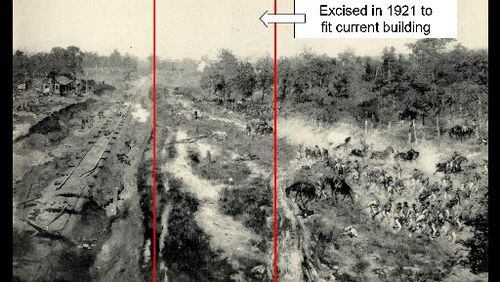Since plans for the move of the Cyclorama from Grant Park to the Atlanta History Center were announced last week, Gordon Jones has responded to countless questions about the anticipated restoration of the massive 1886 painting, especially the planned re-creation of parts removed in 1921.
The pressing need for conservation, then estimated at $8 million, led Mayor Kasim Reed to impanel an advisory group in 2011 to suggest ways to secure the future of the 365-foot panoramic painting that depicts the Battle of Atlanta. Jones, the History Center’s senior military historian, said current projections raise the restoration cost to $11 million.
Challenges include straightening wrinkles in the 5-ton painting, which has been hung like a curtain for decades, with gravity taking its toll, instead of in the tension-mounted hyperbolic (or hourglass) form that was intended to give viewers the illusion of looking at it in 3-D. Moisture issues have to be addressed. And a backing that was applied during a major restoration completed in 1979 may have to be replaced, a delicate operation.
Still it’s the replacement of the missing pieces, trimmed when “The Battle of Atlanta” painting was moved into its current Grant Park quarters, about which most people are curious.
That includes one panel, estimated at 6 feet wide by 50 feet high, that depicts part of the battle. Also, 8 feet of sky will be added back to the top of the painting, running all the way around its circumference.
“They don’t exist anymore. We’d love to find them rolled in somebody’s attic,” History Center President and CEO Sheffield Hale said, while acknowledging that’s unlikely.
The city, which will retain ownership of the treasured artifact, may not have the missing pieces, but the History Center has a good reference to guide it. It has a souvenir book, including crisp black-and-white photographs, published in 1886 when the painting was first shown in Minneapolis. While the booklet’s photos do not provide a 360-degree view, there is an image of the excised battleground section. It fits beside a section depicting destroyed railroad tracks that has been on view for nearly a century.
The section that was removed was at the main seam that was repeatedly cut as the painting was moved from Minneapolis to Indianapolis to Chattanooga and, finally, Atlanta
“If you had to (trim) the painting, this was the place to do it,” Jones said, noting that the main seam ran right above a former tunnel entrance that used to take Grant Park visitors up onto a central viewing platform (that was replaced with rotating bleachers during the 1979 restoration).
“It is possible that this section was ‘eroded’ away, same as the sky, when the seam was cut and re-cut” for its various moves, Jones added.
Jones said the return of the sky will make a bigger impact on viewers because it covers a much larger expanse and will re-establish the intended horizon line for viewers essential to creating the 3-D illusion.
The historian asserted that it’s a mistake to put too much emphasis on the missing pieces, pointing out that the Atlanta Cyclorama is more intact than the one depicting the Battle of Gettysburg was before it underwent a detailed restoration and returned to public view in 2008 at the Gettysburg National Military Park.
“The very fact that so little is missing from this painting makes it unique,” Jones said. “Nearly all others had much more excised from them over the years. ‘The Battle of Atlanta’ is one of the most intact (cycloramas) in the world because it stayed in one place for so long.
“Good for us.”
The conservation team that will undertake the work is still to be selected.






